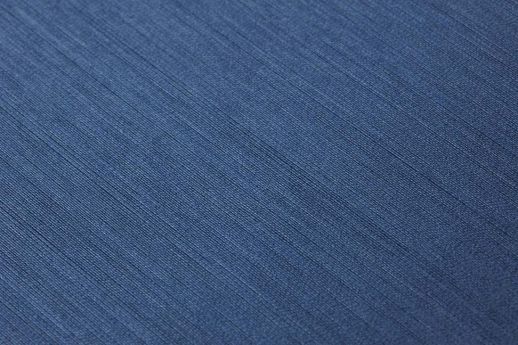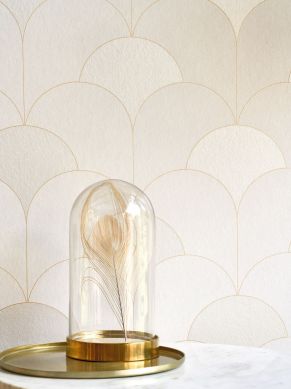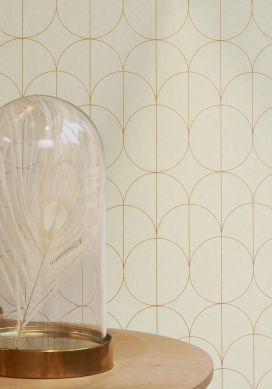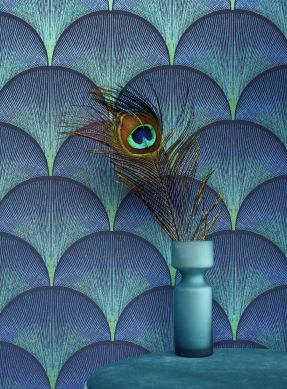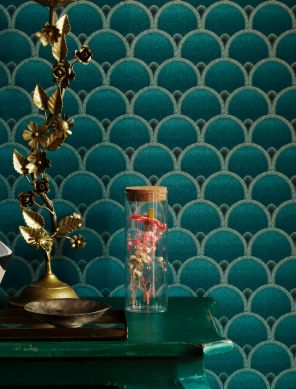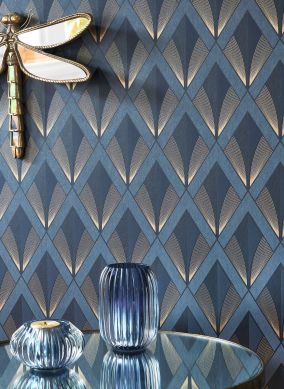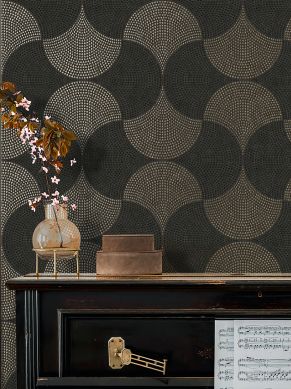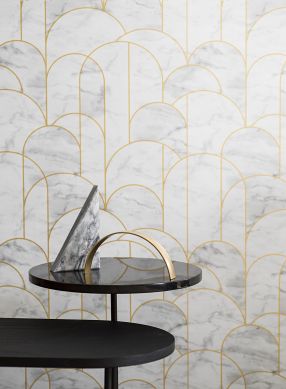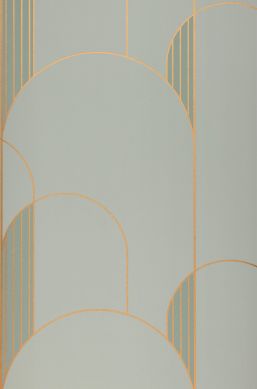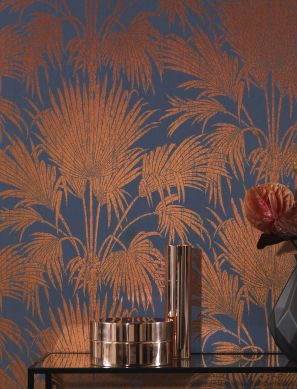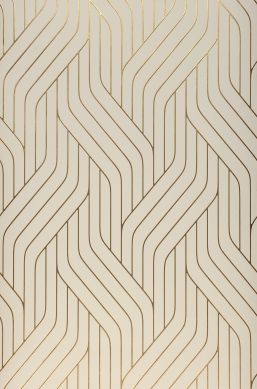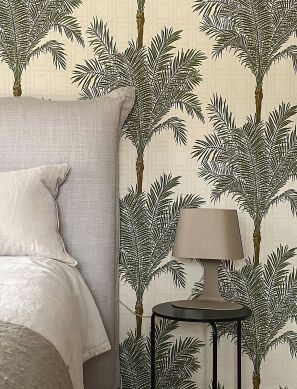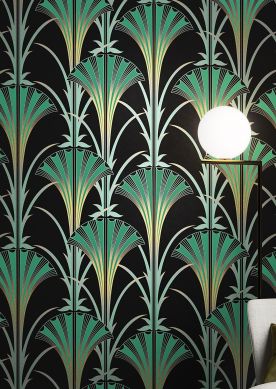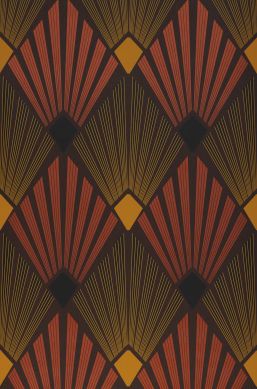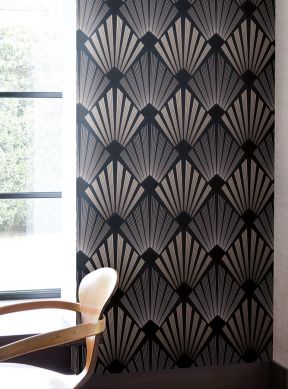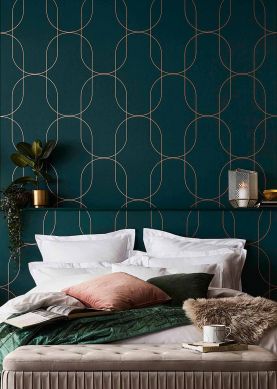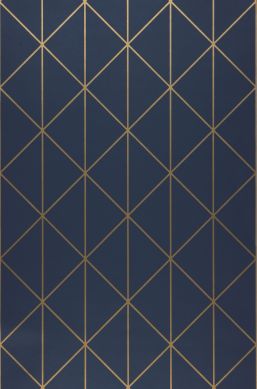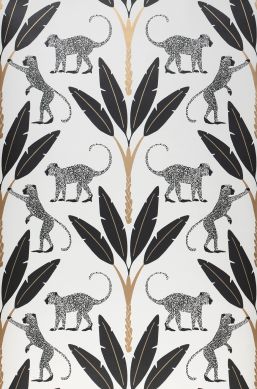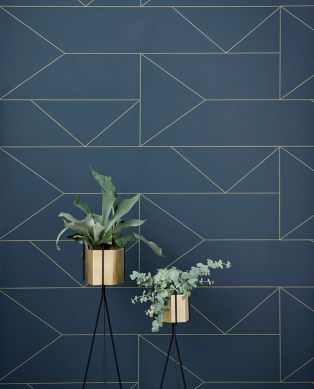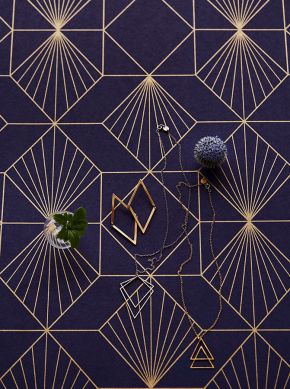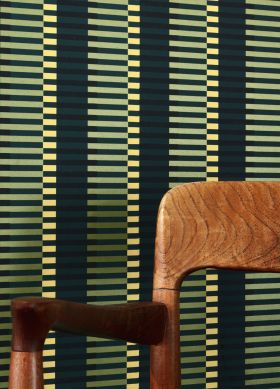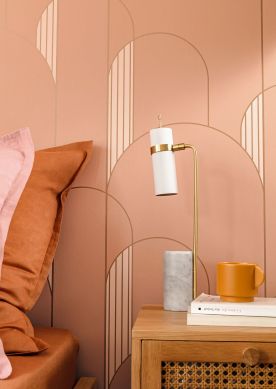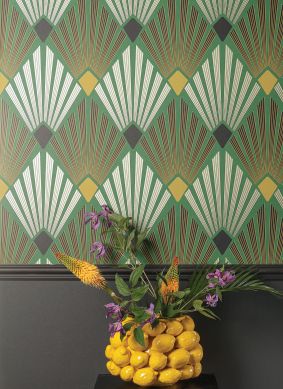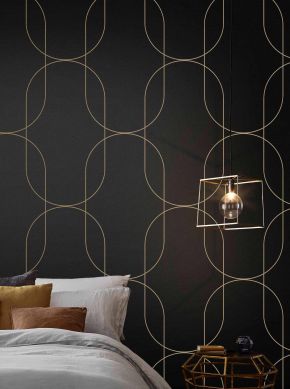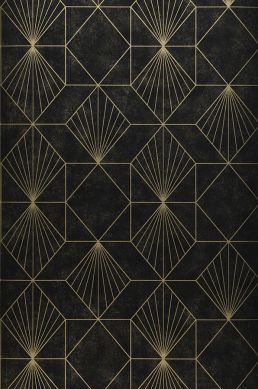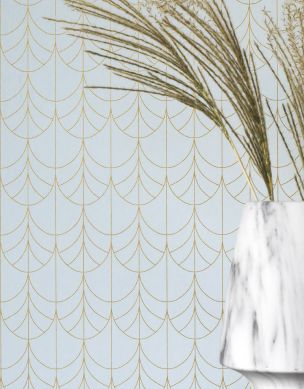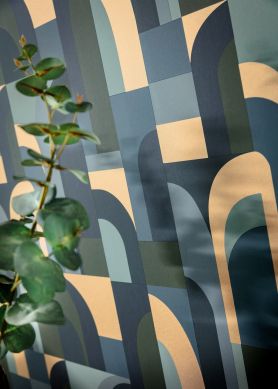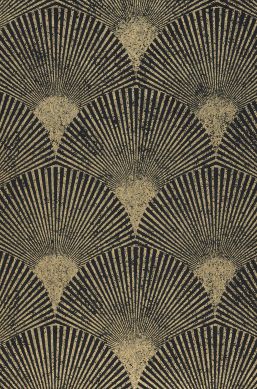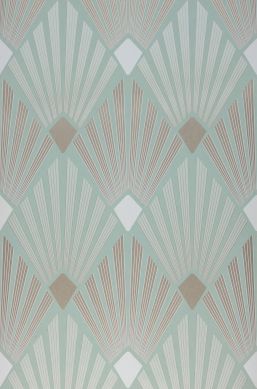Art Deco Wallpaper
Art Deco Wallpaper: The Guide
The Art Deco design era, which is mainly associated with the Roaring Twenties, depicts decorative art in a very modern way. "The Great Gatsby", a dedicated follower and symbolic figure of the decadent 20s style, is the protagonist of writer F. Scott Fitzgerald's acclaimed novel of the same name. The creative era which followed Art Nouveau is characterised by ambivalent stylistic features. It rides the wave of modernism yet remains true to Arts and Crafts values, but it also relies on new industrial achievements, especially in terms of materials. With its light-hearted and frivolous designs, Art Deco expresses an exuberant joie de vivre and a party lifestyle.
Contents
- What are wallpaper models in the Art Deco style?
- Which specific features characterise the luxurious patterns of the Art Deco period?
- What are the most popular pattern motifs of Art Deco wallpapers?
- Why are Art Deco wallpaper models also called "Gatsby wallpaper"?
- What are the most popular colours for Art Deco-style wallpapers?
- Which rooms is Art Deco wallpaper most suitable for?
- Which artists of the Art Deco era inspire today's wallpaper patterns?
- Which wallpaper brands are specialised in Art Deco designs?
- Our tips: Ideas for projects with Art Deco Glam
What are wallpaper models in the Art Deco style?
Art Deco is a glamorous design era that reached its heyday in the 1920s. This decorative art movement which followed Art Nouveau is a light-hearted mixture of stylistic elements with a penchant for pomp.
Glamorous Design Era
Art Deco has its origins in Paris. This cultural design era - which is not represented by any particular movement - covers the period from 1918-1940 and enjoyed its peak in the mid-1920s. In America, literary character Jay Gatsby became the lasting symbol of those intoxicating years.
Decorative Art
Art Deco is the French term for decorative art. The dominance of decorative elements is an unequivocal and significant characteristic of the era. Clear, smooth and elegant forms are all the rage, and their unique charisma is emphasised by strong and pure colours as well as gold and silver touches. Art Deco reflects the magnificent, exuberant party lifestyle of the "Roaring Twenties".
Light-hearted, eclectic mixture of style elements
Floral, organic or concrete motifs are represented in an abstract and two-dimensional way. Slim geometry, sharp breaks and elegant lines form the decorative elements and pattern motifs. The absence of shadows and natural elements creates a strikingly modern style. Industrial production methods open up new interesting working materials such as chrome or plastic.
Succession of Art Nouveau
Art Deco succeeds Art Nouveau, focusing on quality and craftsmanship. It doesn't reject industrial mass production, but instead cleverly uses it as a source of inspiration in terms of design and materials. Modern art - which is constantly evolving - provides the pace and the source of ideas.
Which specific features characterise the luxurious patterns of the Art Deco period?
Art Deco patterns have a high recognition value despite - or perhaps because of - their ambivalent style features. The elegant form, high-quality materials, intense colours, as well as the emphasis on sensuality set the tone for wallpaper patterns in the Art Deco style.
The elegance of form
A clear silhouette, as is inherent in geometry, gives elegance to the form, e.g. stylised floral pattern elements like fanned rhombuses or infinite arcs. New organic geometries are created, which - due to extravagant colour choices - provide a stimulating contrast.
High-quality materials
Precious materials like velvet, silk and brocade are important elements of the style. Glossy and shimmering surfaces, occasionally lacquered, enchant the eye and haptic sense. Pearls, rhinestones and sequins are a must in Art Deco, whether on ladies' flapper dresses and bags or on home textiles.
Strong colours
In this design era, the colours must be bright, intense, exotic and contrasting to meet the demand for extravagance. Red, green and blue are often framed or complemented by gold to take the glam factor to the extreme. Black and gold are another typical Art Deco colour combination.
The sensuality of the theme
The emphasis on the sensuality which characterised the bountiful life of the 1920s expressed through high-calibre and stylish parties is present in all areas of life: Art Deco patterns stand for the new freedom, the unknown, the exotic, but also for technical achievements.
What are the most popular pattern motifs of Art Deco wallpapers?
Art Deco-style wallpaper is characterised by eye-catching floral, geometric and tropical patterns. Fans, champagne fountains and animals are also popular with aficionados of this decorative art.
Fans
One of the most famous painters of Viennese Modernism, Oskar Kokoschka, designed fans as illustrated love letters. The fan, which has been popular in Europe since the 16th century primarily because of its decorative, fashionable component and less because of its function, is a symbolic element. In Art Deco, fans are also seen as tropical-exotic accessories.
Champagne fountain
In Art Deco, life is just one wild party celebrated with champagne flowing endlessly. Stylised champagne fountains are the epitome of this never-ending party frenzy accompanied by swinging music.
Animals
Art Deco loves beauty, luxury, the precious and the extraordinary. In terms of culture, it is very open. This is often expressed via exquisite animal motifs, e.g. cranes or peacocks. The crane is considered to be the bird of happiness, while the proud peacock symbolises beauty, wealth or vanity. Mythical animals are another popular motif, a parallel to Art Nouveau.
Geometric
The clarity and comprehensibility of geometry are perfect for Art Deco designs. Arcs, steps, angles and jagged lines are typical ornaments presented in an inexhaustible variety of designs which are constantly reinvented.
Floral
Stylised and two-dimensional plants, e.g. the leaves of palm trees, ferns, and reeds or the flower heads of roses, tulips as well as delicate blossoms have an important role to play in Art Deco. Quite a few floral pattern motifs are also inspired by the Japanese style.
Tropical
Different countries, different motifs - the Art Deco era features a plethora of tropical pattern motifs that awaken a longing for faraway places and travelling: The jungle, monkeys, coconut trees or crocodile skin... The striking character of these illustrations is based on the absence of naturalness and shadows, giving these patterns a touch of the unapproachable, even the supernatural.
Why are Art Deco wallpaper models also called "Gatsby wallpaper"?
The great Gatsby has gone down in literary and film history as the main character and protagonist of the novel by F. Scott Fitzgerald. The mysterious billionaire is considered a symbolic figure of the Roaring 20s, his lifestyle is the epitome of Art Deco.
Protagonist in the novel by F. Scott Fitzgerald
With the mysterious billionaire and charmer Jay Gatsby who is at the centre of the world-famous novel "The Great Gatsby" (published in 1925), writer F. Scott Fitzgerald created the figurehead of the "Roaring Twenties". This portrait of the Golden Twenties in America - with all its glorious as well as its dark sides - was made into successful movies featuring Robert Redford and Leonardo DiCaprio, among others.
Gatsby as the embodiment of these wild years
Jay Gatsby is "The Face" of the nouveau riche in the golden 20s. He is as unconventional as he is handsome - a mesmerising combination of bon vivant, accomplished liar, gangster and charmer in one person. In his chic Long Island mansion, the cream of New York's society regularly indulges in glamorous parties that are hard to beat in terms of decadence.
Gatsby's style of living is symbolic for Art Deco
In the novel, the description of the interior enables readers to immerse themselves in the decorative arts of the time. The film adaptations, especially the remake with Leonardo DiCaprio, provide a perfect style panorama of life during the times of Art Deco. All the typical features are described in their magnificent opulence.
What are the most popular colours for Art Deco-style wallpapers?
Bright, strong colours, often with striking contrasts, are typical for Art Deco wallpaper. Together with gold and silver, blue, green, red, pink, black and grey are at the top of the favourite colour scale.
Blue
Artistic, sublime, royal - in Art Deco style wallpaper models, blue, the colour of vastness, fantasy and harmony, can vary depending on the pattern and the intended mood. Modern shades of blue such as black-blue, cobalt blue or gentian blue have a powerful and mysterious effect, while ice blue, Aegean blue or dove blue exude a calming and enchanting aura.
Green
Green, the colour of life, nature and hope, gives Art Deco patterns immense presence. Green designs burst with dynamism and invigorate the spirit. Precious stone shades of green such as sapphire, emerald or malachite are also very popular. Blue-green and petrol exude a fresh modernity.
Gold
No one can resist the luxurious splendour of gold. Among the decorative colours, it has the highest value when it comes to the glamour factor. In addition, metallic colours such as aluminium, chrome, copper and brass generally play a major role in Art Deco styles. They represent luxury in a far more subtle way and thus serve a wider range of tastes.
Silver
This cool beauty is in the epitome of modernity. Silver exudes pure elegance and is a very communicative colour. Art Deco designs with/in silver have a mysterious, space-age touch. This is especially true when silver is combined with dark shades of blue and green.
Grey
Grey is the perfect partner for silver and black. Various nuances of this neutral colour come into their own in decorative 20s designs. Grey emphasises their sophisticated aspect and, in combination with white, has an enchantingly light-hearted effect. Brown, copper and brass shades benefit from grey as it adds a glamorous touch.
Black
Black is the perfect contrast colour to all metallic shades used in Art Deco-style patterns. The colour of the night increases any shine or shimmer effect and makes silhouettes stand out in an almost three-dimensional way. Black exudes the charm of the forbidden and the joy of illusion.
Pink
Because the colour is so versatile, modern, decorative art in pink can be romantic, coquettish, psychedelic or trendy. Popular shades of pink are rosewood, watermelon, light pink or powder pink. In terms of wallpaper design, details in copper, brass or silver add sophistication and refinement.
Red
Passion, fire and joie de vivre are associated with the colour red as well as with the Roaring Twenties. Warm and deep, dark shades of red with a hint of brown take precedence over bright signal red which can be somewhat overwhelming. Gold, silver, black and white, soft shades of cream and green can be combined with various hues of red to create a harmonious effect.
Which rooms is Art Deco wallpaper most suitable for?
Wallpaper models in the style of the Golden Twenties transform a variety of rooms into palaces of enchanting modernity. Especially bedrooms, living rooms, hallways and bathrooms benefit from this extravagant look.
Bedroom
Where the gates to the realm of dreams and relaxation are opened and where privacy is a priority, Art Deco wallpapers are an expression of boundless glamorous individuality. Geometric fans, magnificent animal patterns, opulent creations with an Arabic touch and colours such as bronze, night blue, turquoise or gold set the scene in the boudoir.
Living room
This representative, social room can benefit greatly from an elaborate wallpaper design, e.g. stylised champagne fountains, striking graphic patterns or jungle styles. A feature wall which attracts the eye (e.g. behind the sofa) sets the tone for the overall interior design concept. Typical 20s period furniture and opulent curtains made of luxurious materials complete the picture.
Hallway
In the corridor, entrance area and staircase, modern interpretations of the 20s style are true eye-catchers. Art Deco designs with a white background are ideal as they add brightness to these often neglected areas even when there is little daylight. Labyrinth-like, geometric patterns or slender arches work best with the room proportions typical for hallways.
Bathroom
Tropical sceneries embedded in clear-lined geometry, refined with gold - this is an example of successful bathroom design with wallpapers in the Art Deco style. Whether dark or light colours are chosen is up to individual taste and lighting conditions. As half-height wall coverings, marble-look wallpapers are also a great choice for 20s bathrooms.
Which artists of the Art Deco era inspire today's wallpaper patterns?
Many designers are inspired by visual artists who lived and worked in this style era. Amongst the global players often re-interpreted are Henri Matisse, Pablo Picasso and René Lalique.
Henri Matisse
French painter Henri Matisse (1869-1954) is regarded as the founder of Fauvism, which is considered the first movement of classical modernism. His often whimsical themes, playful picture compositions, and planar, bright colours have always inspired art lovers and experts alike. The blue silhouettes depicting abstract female nudes are world-famous.
Pablo Picasso
Spanish painter, graphic artist and sculptor Pablo Picasso (1881-1973) co-founded Cubism together with Georges Braque. In the 1920s, his painting "Les Demoiselles d'Avignon" made him an icon of modern art. From 1924, the artist turned to Surrealism, constantly changing his style and taking inspiration from the old masters.
René Lalique
René Lalique (1860-1945) is one of the most important French jewellery and glass designers of the Art Deco period. However, he also enriched Art Nouveau with his work. His high-quality design objects such as glass vases, bowls, amulets and necklaces with the motifs and colours of the respective style era are among the most expensive collector's items on the planet.
Which wallpaper brands are specialised in Art Deco designs?
Wallpaper patterns in the Art Deco-style are an important part of the product ranges of many manufacturers and producers. Among the world-famous traditional brands known for their exquisite and high-quality Art Deco wallpapers are Zoffany, Pierre Frey and Isidore Leroy.
Zoffany
English wallpaper manufacturer Zoffany has been serving an international clientele since 1983 and offers a wide range of Art Deco wallpaper models. Historical and contemporary patterns are combined to form a new design unit, and soft colours merge with bright tones and metallics. Unusual printing techniques and materials perfect the creations.
Pierre Frey
Replications and re-interpretations of antique and historical pattern motifs from art historical collections are the speciality of the Pierre Frey design manufactory for interior design, which was founded in 1935. The luxurious Art Deco-style wallpapers have an inherent Parisian chic and are bravely extravagant, which is also reflected in the colours.
Isidore Leroy
Since 1842, traditional French company Isidore Leroy has been producing artistic design wallpapers using both traditional and contemporary digital printing processes, including gorgeous models that reflect Art Deco in a contemporary yet timeless manner. The large palette of stylistic motifs in unusual combinations and refreshing colours never cease to surprise.
Our tips: Ideas for projects with Art Deco Glam
- Flapper Girls Salon: For women who want to move through the world on a Charleston beat, the salon in the style of the Golden Twenties is the "place to be". This "party room" wraps itself in glamorous Art Deco design, e.g. rhombuses/fans/arch patterns in gold and black. Furnishing highlights: A baroque-look velvet sofa and a classic pendant lamp with glass-bead fringes.
- Clever storage space in the bedroom: Beautify a wall with opulent, perhaps tropical Art Deco wallpaper. A DIY storage unit made of white (floating) shelves provides room for shoes, shirts and bags. The shelf is cleverly hidden behind a luxurious (ceiling-mounted) curtain, the rest of the wall displays the decorative motif.
- Gatsby Style Dining Room: Indulge in fabulous memories and dine like the Great Gatsby himself. Put a geometric, two-tone Art Deco pattern wallpaper halfway up a feature wall. Paint the upper part of the wall in a strong colour. Cover the transition area between wallpaper and painted wall with picture rails with large-scale photographs from the 1920s.
- Avant-garde office & meeting room for creatives: Art inspires! Art Deco pattern designs brought forward into a new form language open up new perspectives during creative breaks. Choose interlaced, graphic patterns for a feature wall and establish a clear line in your interior design.


